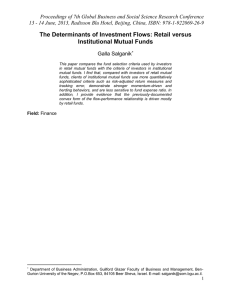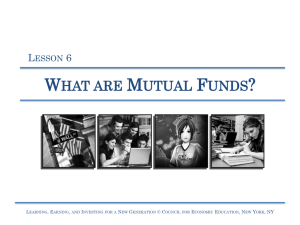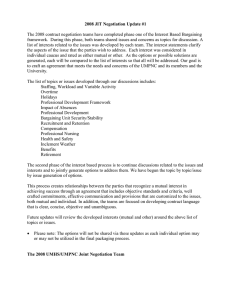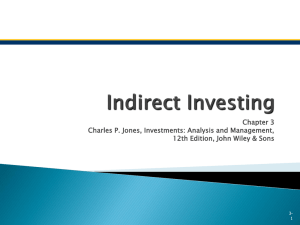Chapter 3 Investments Funds
advertisement
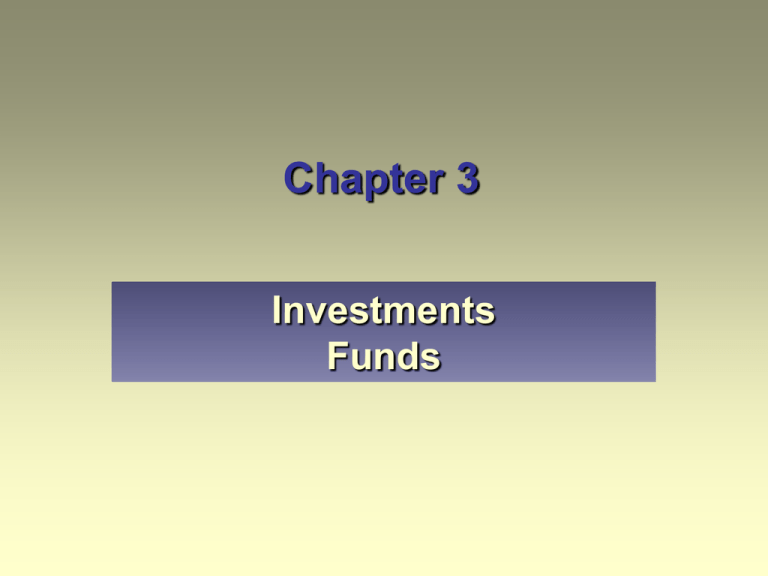
Chapter 3 Investments Funds Learning Objectives • Distinguish between direct and indirect investing. • Define open-end and closed-end investment funds. • State the major types of mutual funds and give their features. • Define exchange-traded funds (ETFs). Learning Objectives • Explain the transactions behind indirect investments. • Understand how the performance of investment funds is measured. • Discuss the opportunities for investing indirectly internationally. Investment Choices • Three investing choices: 1- Hold the liabilities of traditional intermediaries, such as banks & insurance companies (e.g. savings accounts, GICs, and so forth) 2- Hold securities directly by purchasing stocks and bonds through brokers and other intermediaries 3- Hold securities indirectly through investment companies, pension funds, & mutual funds Indirect Investing • Refers to buying and selling the shares of intermediaries that hold a portfolio of securities Shares are ownership interest in the underlying portfolio Shareholders are entitled to portfolio income (e.g. dividends, interest, & capital gains generated) Shareholders also pay expenses (e.g. fund expenses and management fees) Total Net Assets 1993 to 2003 450 400 $Billion 350 300 250 200 150 100 50 0 1993 1994 1995 1996 1997 1998 1999 2000 2001 2002 2003 Investment Fund • Financial company or trust fund that sells shares to the public and uses the proceeds to invest in a portfolio of securities such as money market instruments, stocks, & bonds Acts as an intermediary for distribution of dividends, interest, and realized gains Offers the benefits of diversification Offers professional management Investment Fund Investors • Investment funds are ideal for investors: 1- With small amounts of capital to invest who cannot properly diversify it on their own 2- Who do not have adequate time to manage their own investments 3- Who do not wish to manage their own portfolio Types of Investment Funds 1- Unit Investment Trust: an unmanaged, fixedincome security portfolio put together by a sponsor and handled by an independent trustee Redeemable trust certificates representing claims against the assets of the trust are sold to investors The assets are almost always kept unchanged and the trust ceases to exist when the bonds mature Types of Investment Funds (cont.) 1- Unit Investment Trust (cont.): Passive investments designed to be bought and held with capital preservation as a major objective Currently represent a very small part of total investment company assets Types of Investment Funds (cont.) 2- Closed-end investment fund: An investment fund with a fixed capitalization whose shares trade on exchanges and over-the-counter (OTC) markets No additional shares sold after initial public offering Share prices determined and traded in a secondary market, i.e., on exchanges like any other stock Price may not equal Net Asset Value of the shares • Net Asset Value (NAV): Total market value of the security portfolio divided by total shares Types of Investment Funds (cont.) 3- Open-end investment fund: An investment fund whose capitalization constantly changes as new shares or trust units are sold and outstanding units are redeemed Popularly called mutual funds Account for a large majority of aggregate funds invested in Canada (from 294 with $20.4 billion in assets in 1988 to 1,887 with $439 billion in 2003) Are formed either by creating a mutual fund company and selling shares in it, or by creating a mutual fund trust and selling “units” in it. Types of Investment Funds (cont.) 3- Open-end investment fund (cont.): Mutual funds can be purchased directly from a fund company (e.g. mail or telephone) or indirectly from a sales agent (e.g. securities firms and banks) Maybe affiliated with an underwriter, who usually has an exclusive right to distribute shares to investors Mutual funds are the most popular form of investment funds for the average investor because of their small minimum investment requirements (usually $1,000 and larger funds need as little as $200) Mutual Fund Examples • As of March 2004, RBC Asset Management Inc., a subsidiary of the Royal Bank of Canada, was the largest mutual fund company in Canada with assets of over $44.1 billion. • Investors Group was the second largest company with total assets exceeding $42.6 billion. Calculating Net Asset Value • Using the numbers from RBC Asset Management Inc.’s 2003 annual report for the RBC Canadian Equity Fund, the year-end NAV is calculated as follows: Total Assets $3,354,161 Total Liabilities 8,752 Net Assets $3,345,409 Units outstanding 193,959 NAV = $3,345,409 / 193,959 = $17.24/unit Types of Mutual Funds • The board of directors (or trustees) of an investment fund must specify the objective that the fund will pursue in its investment policy • The companies try to follow a consistent investment policy, according to their specifies objectives • This will have a great deal of influence on the investor’s purchase decision Types of Mutual Funds (cont.) 1- Money Market Funds (MMFs) Objective is a high level of income and liquidity Investments include short-term money market instruments (e.g., treasury bills & commercial paper) Attractive to investors seeking low risk and high liquidity The average maturity of money market portfolios ranges from 1 to 3 months Investors in MMFs earn and are credited with interest daily Types of Mutual Funds (cont.) 1- Money Market Funds (cont.) MMFs are not insured Created in 1974 when interest rates were at record high levels By March 31, 2004, Canadian MMFs had total assets equal to $51.3 billion accounting for 11.1% of all Canadian mutual fund assets. Types of Mutual Funds (cont.) 2- Mortgage Funds Investment terms may be 5 years Riskier than money market funds (more interest rate risk due to longer maturities), but less risky than bond funds (shorter maturities) 3- Bond Funds Objectives of income and safety Subject to capital gains/losses due to interest rate risk Types of Mutual Funds (cont.) 4- Balanced Funds (e.g. AGF Canadian Balanced Fund) Objective is to provide a mixture of safety, income and capital appreciation Min./max. rules apply for percentage invested in each asset class. Example: In Feb. 27, 2004, the portfolio of AGF Canadian Balanced Fund was composed of 56.7% equities, 29.1% bonds, and 14.2% cash and shortterm securities. Types of Mutual Funds (cont.) 5- Asset Allocation Funds Similar objectives as balanced funds, but typically not restricted to holding specified minimum percentages in any class of investment 6- Equity/Common Stock Funds Objective of capital gains Bulk of assets are in common shares, but other assets are held for liquidity, income and diversification purposes May vary greatly in degree of risk and growth objectives Types of Mutual Funds (cont.) 7- Growth Funds Tend to invest in small-cap stocks, i.e. small companies with growth potential Riskier than equity funds (small firms pay no dividends and have a higher risk of default) 8- Specialty Funds Objective of superior capital gains (through minimal diversification) Tend to focus on companies in one industry, one segment of the capital market, or in one geographic location International/Global Funds, for example, invest in foreign securities (and carry the risk of foreign exchange exposure) Types of Mutual Funds (cont.) 9- Real Estate Funds Invest in income-generating properties for long-term growth and capital gains Portfolio valuation is based on infrequent (monthly or quarterly) external appraisal Less liquid than other funds – investors may need to give advance notice when selling 10- Ethical Funds Relatively new type of fund Investments are guided by moral criteria (e.g., not investing in tobacco-related firms) Types of Mutual Funds (cont.) 11- Index Funds Objective is to mirror the performance of a market index (e.g., S&P/TSX Composite Index) Generally lower management fees than actively managed funds. 12- Dividend Funds (e.g. Altamira Dividend Fund) Objective of tax reduction through favourable treatment of dividend for companies Inappropriate for RRSPs where the credit cannot be applied Price changes are driven by interest rates and market trends Types of Mutual Funds (cont.) 12- Dividend Funds (cont.) Example - The objective of the Altamira Dividend Fund is to achieve the maximum level of dividend income as is consistent with the prudent levels of capital preservation and liquidity - The fund invests primarily in common and preferred stocks that pay dividends - The fund invests mainly in Canadian companies so that investors can benefit from the favourable tax treatment of dividends - As of Feb. 27, 2004, the fund had 41% in financial services, 13% in utilities, and 14% in bonds. Types of Mutual Funds (cont.) • Each type of fund has different risk-return characteristics. In general, they can be ranked from lowest risk/return to highest risk/return as follows: 1. Money market 2. Mortgage 3. Bond 4. Balanced 5. Dividend 6. Equity 7. Real estate 8. Specialty Mutual Fund Categories • Money market mutual funds invest in a portfolio of money market securities Treasury bills Commercial paper Short-term government bonds Low risk Not insured by the federal government Mutual Fund Categories • Equity, bond, and income funds invest in portfolios of securities consistent with the objectives of the particular fund Objectives set by the fund’s board Disclosure of objectives to investors through a prospectus Equity Funds • Most mutual fund assets are in equity funds rather than bond or income funds • Most equity funds are either: Value funds: which invest in cheap (undervalued) stocks as determined by fundamental financial analysis items, such as, earnings and dividend yield Growth funds: which invest in stocks of firms expected to show future rapid earnings growth even if current earnings are poor or non-existent Equity Funds (cont.) • Closed-End Funds NAV > market price, selling at a discount NAV < market price, selling at a premium On average, closed-end funds tend to sell at a discount from their NAV. Reasons: 1- illiquidity 2- high expenses 3- poor performance 4- unrealized capital gains Equity Funds (cont.) Example: On May 25, 2004, shares of the Canadian General closed-end fund closed trading on the TSX at $12.75, which represented a discount of 26.8% from its NAV per share of $17.42 Closed-end funds trade at premiums and discounts across time, and the variance between funds is great Example: over a recent 5 year period, closed-end funds were trading at discounts averaging 11%, while a US closed-end fund (the Thai Capital Fund) was trading at a premium of roughly 55%. Load vs. No-Load Funds • Mutual funds can be subdivided into load funds (those that charge a sales fee) and no-load funds (those that do not) • Load funds charge investors a sales fee for the costs involved in selling the fund • Investors either pay the fee initially when the fund units are purchased (front-end sales charge), or in the future when the sales are redeemed (back-end charges) • Offering or purchase price = (NAV)/(100%-sales charge) Example- Load vs. No-Load Funds • What is the offering price for a fund that has a NAV of $10 and a 5% upfront sales charge • Offering price = $10/(1.0-0.05) = $10.53 • Notice that $0.53 is 5.3% of the NAV. • Regulators require that the firms report sales charges in their prospectus. Load vs. No-Load Funds (cont.) • In 2004, 70% of Canadian mutual funds charged loads. • Front-end sales charges – 4% • Back-end (redemption) charges – 18% • Option between front-end and back-end charges – 48% • The remaining 30% of funds were no-loads that did not charge direct selling charges. • No-load funds charge administration fees and early redemption fee (usually 2%) Exchange-Traded Funds (ETFs) • An ETF is an index fund holding a diversified portfolio of securities, priced and traded on public exchanges • Most ETFs are passively managed fund • Unlike mutual funds, investors don’t buy shares of ETFs from investment companies directly, but rather from other investors • ETFs involve regular brokerage transactions and fees. • This makes the ETF resemble a closed-end fund in many respects Exchange-Traded Funds (ETFs) • Units of these trusts hold shares of firms in market indices in proportion to their weights in the index • Differences from traditional mutual funds: Traded throughout the day on exchanges Lower management fees (e.g., 0.08% to 0.25% versus 2.5% average for active equity funds versus 0.75% average for Index funds) Lower portfolio turnover – reduces capital gains income and taxes payable Permit short-selling (Ch. 4) May be purchased on margin (Ch. 4) Canadian-Based ETFs • I-60s (most widely traded Canadian ETFs) • Represent units in the S&P/TSX 60 Index Trade on the TSX (ticker: XIU).; units are valued at 1/10th the value of the S&P/TSX 60 Index; for example, if index is valued at 450, each unit is valued at $45 Dividends are paid every quarter; MER is 0.17% DJ40s Represent units in the Dow Jones Canada 40 Index Participation Fund, which hold stocks that mimic those of the Dow 40 Index; MER is 0.08% Canadian-Based ETFs • TD S&P/TSX Index Fund • The S&P/TSX Composite Index is the underlying index; MER is 0.25% There are now a growing number of small-cap, mid-cap, industry-based, style-based, and bond ETFs available on the TSX Differences between ETFs and Mutual Funds • ETFs Trade all day on exchanges, can be bought on margin, and can be shorted Currently passive in nature Can be traded at discount or premiums. Offer an important advantage over funds with regard to flexibility on taxes • Mutual Funds Bought and sold at the end of the trading day when the NAV is calculated Most are actively managed Trade at NAV Mutual fund mangers may have to sell shares to pay those who want to leave the fund, thereby generating capital gains Other Funds • Segregated funds Offered by insurance companies as alternatives to mutual funds Provide death benefits Guarantee that, regardless of how poorly the fund is performing, investors are entitled to at least a minimum percentage of their total contributions to the fund A minimum percentage (75% is required, 100% is usually offered) of investor’s payments will be returned at fund maturity (or at death of owner) The guarantee is only good for a certain period of time. If investors sell their funds before this date they may receive less than the guaranteed percentage Other Funds Structured to prevent fund assets from being seized by creditors if investor declares bankruptcy Upon owner’s death, assets may be transferred to beneficiaries without being subject to probate fees These funds have grown in popularity in recent years, with assets growing from $20 billion in 1991 to $89 billion in 2002 Segregated funds tend to have higher load fees Other Funds • Labour Sponsored Venture Capital Corporations (LSVCCs) Are sponsored by labor organizations with a specific mandate of investing in small and mediumsize businesses Main objectives is to create and protect jobs, promote economic growth and diversification, increase the supply of venture capital, & encourage greater participation in share ownership Eligible investments for LSVCCs is restricted to taxable Canadian businesses that are active in Canada Other Funds • Labour Sponsored Venture Capital Corporations (LSVCCs) Tax advantages – federal tax credit of 15% & provincial tax credit in the 15-20% range While there is no maximum amount an investor may invest in an LSVCC, the total tax credit cannot exceed $1,500 in any year Most LSVCCs are RRSP eligible, which implies the potential of a double tax advantage Investors must be aware of the highly speculative and illiquid nature of LSVCCs since the portfolios are generally not well diversified and are composed of venture capital investments in small and medium size firms with no established track record Other Funds • Labour Sponsored Venture Capital Corporations (LSVCCs) Unlike mutual funds, LSVCCs: Are not restricted to 10% ownership in given companies (they may exceed 20%) Have restrictions on transferability and redemption Valuation may not be based exclusively on market prices, but rather, may require valuation by independent qualified persons Performance • Reported on a regular basis (usually daily) in the popular press (e.g. The Globe and Mail, National Post, Business Week, and Forbes) • Measured over a given time period as a percentage of initial investment Total return for a mutual fund includes reinvested dividends and/or capital gains Total return includes all the ways investors make money from financial assets Total return is stated as a percentage and can cover any time period- one day, one month, one year, or several years Performance A cumulative total return measures the actual performance over a stated period of time, such as, the past three, five, or ten years Average annual total return reflects the mean compound growth rate of investment over a given time period Average annual total return allows investors to make direct comparisons among funds so as to their performance. However, the risk of the funds being compared should be equivalent and the funds should have the same general objectives Performance • Investors relate the performance to some benchmark to judge relative performance with a comparable investment alternative • An important issue is expenses: funds with low MERs provide better returns in the long run (since management expenses reduce investors’ returns) • Mutual fund ratings: best known rating system is provided by Morningstar • Globefund is a major provider of information and ratings for Canadian mutual funds • Although past fund performance provides useful information for investors, strong past performance is no guarantee of strong future performance International Investing Through Investment Funds • The mutual fund industry has become a global industry • Open-end funds (mutual funds) around the world have grown rapidly, with worldwide assets of approximately $11.6 trillion US by mid-2002 • Canadian investors can invest internationally by buying and selling international funds International Funds • Some mutual funds specialize in international securities Canadian investors can participate in emerging market economies International diversification International funds or global funds emphasize international stocks Single-country funds concentrate on the securities of a single country • Actively or passively managed New Directions in Funds • Mutual fund “supermarkets” Various mutual fund families can be purchased through a single source Brokerage firms may provide access “Supermarket” managers earn fee which is paid by the funds participating in the supermarket (0.25% to 0.4% of assets per year) • On-line investment services Internet used to provide mutual fund information and to make transactions
